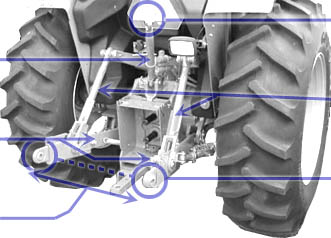

By 1960, Ferguson's patents had expired and a judge refused to extend them, noting their value to agriculture. Most major manufacturers developed a a similar hitch, each with variations to avoid violating Ferguson's patents. The success of the three-point hitch on Ford N-series tractors led other manufacturers to begin building their own versions of the hitch. Ford eventually settled a lawsuit with Ferguson for over $9 million, but it was the beginning of the end for Ferguson's exclusive control over his three-point system. Ferguson began production with another company (Ferguson Tractor, which joined with Massey-Harris in 1959). In 1947, Henry Ford II was in control of Ford and decided continue production without Ferguson's involement. The N-series tractors became a great success for Ford. The result was the Ford model 9N in 1939. Ferguson impressed Ford enough to enter into a production agreement (known as the "handshake agreement", because very little of the business arrangments were formalized on paper). In the autumn of 1938, Ferguson met with Henry Ford to demonstrate his tractor and hitch system. By 1937, however, poor sales and disagreements between Ferguson and Brown caused production to stop. He met with a number of tractor manufacturers and eventually reached a deal with David Brown in 1933, resulting in the production of the Ferguson-Brown model A, with Ferguson's three-point system. Ferguson's mounting system evolved from two link arms (one top, one bottom) to three, and from spring-assisted lift to hydraulics. His early work with mounted plows used a modified Ford model T automobile and later a Fordson model F tractor. Early tractors were very heavy and employed steel lugs to try and achieve enough traction.įerguson began experimenting with mounted plows while working for the Irish Board of Agriculture. Often, the biggest problem was not the raw power of the tractor, but gaining enough traction to put the power to use. Most early tractor plows were trailer-mounted and merely pulled behind the tractor. This period provided Ferguson with considerable experience at the start of mechanized farming in Ireland and England. During World War I, Ferguson served as a sales agent in Ireland for the Overtime tractors, which were imported Waterloo Boys. If you have any questions about hitch settings or John Deere tractors, you can contact your local John Deere dealer.The modern three-point hitch began with experiments by Harry Ferguson in the 1920s and 1930s.
3 point hitch draft control full#
To activate float mode, press the hitch control lever full forward, then downward, locking it into the float position.

It allows the hitch to raise and lower with minimal resistance to allow the implement to follow the contour of the ground. Float mode is intended to be used with implements that are self-supporting with gauge wheels. Slip sensitivity can be deactivated by changing slip sensitivity settings to zero. It is then lowered back to the set position once wheel slip has decreased.

Tires Foot Fuel Throttle Rear Diff Lock Draft Full 3 Point with Top Link. The implement will be raised if wheel slip is increased above your desired setting. JOHN DEERE 950 Tractor ONLY 1543 Hours 4WD DIESEL 31HP 1.7L 3 Cylinder 8 Speed. Without one or both, slip sensitivity will be unavailable or grayed out on the display monitor. Draft Control with Slip Sensitivity requires low depth to be activated and a functional ground radar. While traveling at your desired depth and ground speed, depress the hitch button – this records the hitch depth set position. Lower the implement into the ground using the hitch control lever or depth adjust dial to achieve your desired depth. To activate Draft Control mode, first adjust the slope depth setting to somewhere between 1 and 5 – the help page in the Operations Center will provide suggestions for different types of implements. Draft Control automatically lowers and raises the implement in rolling terrain to keep draft loads or implement loads consistent. Depress the set button to save the hitch depth’s set position. From here, you can adjust the hitch position using either the hitch control lever or depth adjust dial. Change both load depth and slip sensitivity settings to zero. To activate this mode, navigate to the hitch page in the Operations Center by depressing the hitch button on the navigation bar. Position mode lowers the hitch to a set position and keeps it at that position, regardless of draft loads. Let’s take a look at the four hitch settings and how they operate to gain a better overview of their purposes. Understanding the different settings is essential to making the most of your tractor and getting the job done in a safe, efficient manner. There are various hitch settings available on John Deere tractors.


 0 kommentar(er)
0 kommentar(er)
